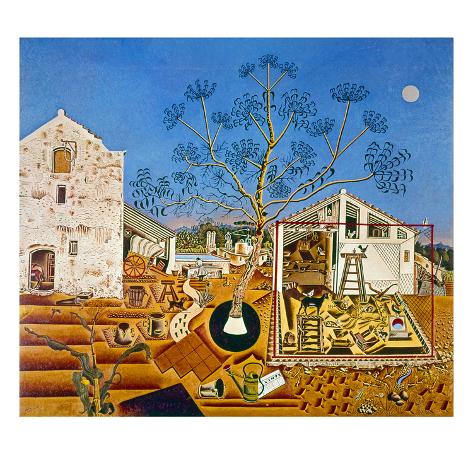
It is a kind of inventory of the masia (traditional Catalan farmhouse) owned by his family since 1911 in the town of Mont-roig del Camp. The Farm is an oil painting made by Joan Miró between the summer of 1921 in Mont-roig del Camp and winter 1922 in Paris. The painting had spent years in a house with ceiling leaks and no air conditioning, on a damp, tropical island.National Gallery of Art, Washington, D.C.

When MoMA staff got their first look at The Farm, they were shocked. They had to wait until after the collapse of the Batista Regime and the coming to power of Fidel Castro.ĭuring the first week of February, 1959, Vance managed to fly in to Cuba, get the painting and bring it back to New York. MoMA curator, Jim Soby, and assistant registrar, David Vance, devised a plan to get the painting out of revolutionary Cuba.
#The farm miro how to#
Hemmingway said that if MoMA wanted the painting, MoMA would have to figure out how to get it.

Hemmingway and Mary had left Cuba and settled in Ketchum, Idaho. Also, the painting did not, technically, belong to Hemmingway, but still belonged to his first wife, Hadley. The catch was that the painting was in Cuba and Cuba was in the throes of a revolution. Barr wanted the painting for a major Miro exhibit scheduled for 1959. In 1957, Hemmingway and his fourth wife, Mary, went to MoMA and offered The Farm to Barr. Hemmingway apologized to Barr, saying that the painting was in too poor a condition to ship. By then, Hemmingway was married to his third wife, Martha, and the painting was at their home in Cuba. In 1941, MoMA director, Albert Barr, asked Hemmingway to loan the painting to the museum for a Miro exhibit. The painting was not returned to Hadley, but to Hemmingway and his second wife, Pauline, who were living in Key West. Hadley and her second husband loaned The Farm to the Art Institute of Chicago in 1934. Hemmingway divorced his first wife, Hadley, and told her that she could have The Farm. The Farm combined surrealism, cubism and a strong sense of color which would be recognized as the seminal work that moved Miro to create the abstract style that became uniquely his own.Įrnest Hemingway and his fourth wife, Mary, with Miró’s painting of The Farm at their home near Havana in the 1940s. Joan Miro painted the family farm from memory while living in Paris. In the nearly 100 years since the painting was completed in Paris, it has traveled thousands of miles and changed hands many times, before its return trip this year. Miro would return from Paris each summer to his family’s farm in the village of Montroig, and even took Hemmingway on a visit to the farm. Miro was having difficulty selling his paintings and Hemmingway was piling up rejection slips from publishers. Miro and Hemmingway, both in their twenties, became friends. to Paris, working as a foreign correspondent for the Toronto Star. Around the same time, Ernest Hemmingway moved from the U.S.

Joan Miro moved from his home Barcelona to Paris, in 1920, to be part of the cutting edge artistic movement that was taking place there. One of the most impressive works in the exhibit is The Farm, whose history is almost as interesting as the painting itself.


 0 kommentar(er)
0 kommentar(er)
